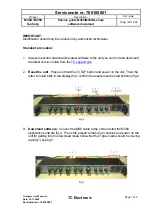
page 3 – 60
AM-10HD / Aug 2008
A M - 1 0 H D G U I
HF Correction
The performance of all AM transmission systems is constrained
to varying degrees by less than infinite bandwidth. Whether or not
this limited bandwidth creates a modulation control problem at high
frequencies is usually a matter of degree.
Many transmitters/antenna system combinations will not require
correction in their High Frequency response in order to minimize
modulation overshoots. However, if the transmitter is operating into
a fairly high‑Q antenna system or common point, then some correc‑
tion of the overall response at high frequencies may be beneficial.
When bandwidth restrictions cause modulation overshoot the
best way to minimize it is to (1) reduce the bandwidth of the signal
entering the transmission system, (2) reduce the rise time of wave‑
forms exiting the audio processor, or (3) perhaps a combination of
both if the problem is quite serious.
If desired, the transmission system’s high frequency pulse response may be ana‑
lyzed using the tools contained within the AM‑10HD to determine if HF correction
should be applied.
This procedure is as follows:
1. Connect the AM‑10HD to the audio input of the transmitter to be tested.
2. Connect the transmitter to either a dummy load of rated power or to the an‑
tenna system.
3. Turn on the AM‑10HD’s Test Oscillator. Adjust it to a frequency of 8kHz.
Adjust the Test Oscillator Level control and the Analog 1 or Analog 2 output
(as appropriate) until approximately 80% modulation is indicated on the sta‑
tion’s modulation monitor. Ensure that the HF Correction “L: (level) controls
are set at 0dB.
4. Turn on the AM‑10HD Test Oscillator “Tilt Test” by clicking its checkbox.
5. Using an oscilloscope connected to a low level RF sample of the transmitter
output observe the resulting RF waveform.
6. If the transmitter has adequate HF response the waveform will appear similar
to figure C.
7. If it has less than adequate response the waveform will appear similar to that
in Figure A.
8. Depending on the magnitude of HF correction required the waveform’s ap‑
pearance may even appear to be somewhat between Figures A and C.
9. If the response of the transmitter does not resemble the perfect low frequency
response represented by Figure C, alternately adjust the HF Corrector’s “F”
(Frequency), “Q” (Bandwidth), and “L” (Level) controls in order to achieve
the flattest top and bottom of the waveform.















































